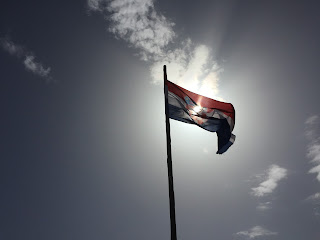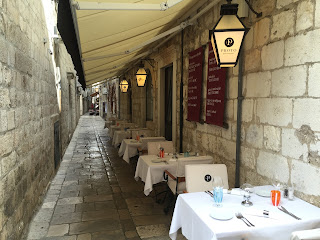Croatia is a nation that Europeans favor as a vacation destination. It has a long coastline in the Adriatic Sea with a thousand islands and isles, providing a year-long mild climate.
Croatia used to be part of the former Yugoslavia. Croatia was one of the first countries that declared independence from the former Social Federation of Yugoslavia that consisted of six countries, but broke up in 1991-1992.
Kristin and I had an opportunity to visit a few places in Croatia.
With this travertine development, numerous magnificent waterfalls are created.
There are hiking trails around the lakes and the views are stunning. The water color changes due to mineral contents, sun lights and shades of clouds. It was the most pleasant surprise to us to hike around the lakes.
It was registered as a UNESCO World Natural Heritage site in 1979
.
 |
| A borrowed photo from Google |
Since photos could not convey the refreshing sounds of the lake falls, here is the first ever video clip that I am uploading. I hope it works.
Split: Split is a town on the Dalmatian Coast. It is famous for a fortress-like palace built by the Romans in the 4th century. The palace, called Diocletian's Palace, has more than 200 buildings of white stones and they are actively utilized for cafes, bars, residences, restaurants, retail stores and cathedrals.
It was a strange feeling to walk around the alleys of the complex, which could have been heritage sites for any country. We had a dinner at a restaurant located in a courtyard in the middle of the palace, listening to a duo musician. Between buildings, clothes were put out on strings for natural drying.
It was a strange feeling to walk around the alleys of the complex, which could have been heritage sites for any country. We had a dinner at a restaurant located in a courtyard in the middle of the palace, listening to a duo musician. Between buildings, clothes were put out on strings for natural drying.
Dubrovnik: Dubrovnik is a UNESCO world heritage site and the best known Croatian city to outsiders particularly for the city wall that surrounds the city. Walking on the city walls gives you not only panoramic view of the town but also the view of the sea and five forts that were established to watch any external threats.
Within the city walls were lime stone roads that were packed with restaurants, bars, cafes, retail shops and historic buildings that range widely from Baroque to Renaissance to Gothic. All streets were crowded with tourists that included passengers for a few cruise lines.
Croatia's coastline is called Dalmatian Coast because the region used to be Dalmatian Empire. But its more than 1,000 islands and isles along the coastline gave the name for the dog breed that has white skins and black spots that originated from the region.
Within the city walls were lime stone roads that were packed with restaurants, bars, cafes, retail shops and historic buildings that range widely from Baroque to Renaissance to Gothic. All streets were crowded with tourists that included passengers for a few cruise lines.
Croatia's coastline is called Dalmatian Coast because the region used to be Dalmatian Empire. But its more than 1,000 islands and isles along the coastline gave the name for the dog breed that has white skins and black spots that originated from the region.
St. Blaise is revered in Dubrovnik as the city's protector. The town has 39 big and small statues of St. Blaise everywhere.
Due to the city's access to Adriatic Sea, seafood was popular and delicious. Starving from seafood in Rwanda, a land-locked inland country, we indulged ourselves with seafood.
We had to cross the border lines of Bosnia twice to reach Dubrovnik from Split because there is a piece of coastal land of Bosnia (9 km) within Croatia. I am sure it was negotiated as such for Bosnia to have access to the ocean. In effect, Dubrovnik is an isolated outpost for Croatia. This interesting geography is the result of Debrovnik Empire gave a piece of land to Turkey to seek protection against Venetians. At any rate, once Croatia becomes a member of EU, Croatia's tourism may be adversely affected.
Croatia's capital is Zagreb located inland to the north east. It also is a historic city but plays an important role administratively, but we did not get to visit this city this time. - Jeffrey




































No comments:
Post a Comment